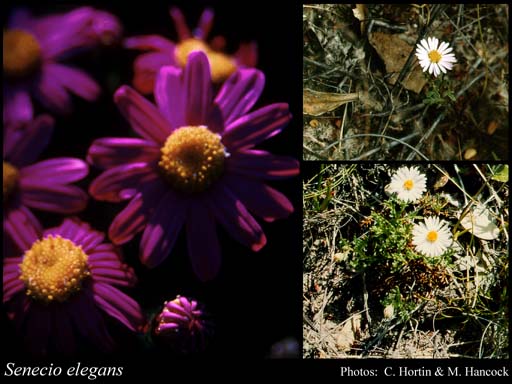- Reference
- Sp.Pl. [Linnaeus] 2:869 (1753)
- Conservation Code
- Not threatened
- Naturalised Status
- Alien to Western Australia
- Name Status
- Current
Erect annual, herb, 0.1-1 m high. Fl. purple/red/pink/yellow, Sep to Dec or Jan to Mar. White or grey sand. Coastal dunes & cliffs.

Distribution
- IBRA Regions
- Esperance Plains, Jarrah Forest, Swan Coastal Plain, Warren.
- IBRA Subregions
- Fitzgerald, Perth, Recherche, Southern Jarrah Forest, Warren.
- IMCRA Regions
- Leeuwin-Naturaliste, WA South Coast.
- Local Government Areas (LGAs)
- Albany, Augusta Margaret River, Busselton, Denmark, Esperance, Mandurah, Manjimup, Nannup, Nedlands.
Management Notes (for the Swan NRM Region)
Alternative Names. Purple Groundsel, Purple Ragwort, Wild Cineraria.
General Biology. Growth form. Herb. Life form. Annual. Reproduction. Seed. Dispersal. Wind, garden waste, plantings.
Notes. Only persists in disturbed sites. Naturalised in Australia, New Zealand and the United States. Seed germinates freely in autumn with the onset of winter rains. Increased salinity decreases germination rates and time. Flowers.
Additional information. Origin. South Africa, Cape Province. History of use/introduction. Ornamental.
Suggested method of management and control. Hand remove isolated/small populations. Otherwise apply Lontrel® at 10 ml/10 L + wetting agent before stem elongation in late spring. Read the manufacturers' labels and material safety data sheets before using herbicides. For further information consult the Australian Pesticides and Veterinary Medicines Authority to determine the status of permits for your situation or state.
Management Calendar
| Calendar Type | Jan | Feb | Mar | Apr | May | Jun | Jul | Aug | Sep | Oct | Nov | Dec | Comments |
|---|---|---|---|---|---|---|---|---|---|---|---|---|---|
| Germination | Y | Y | Y | Y | O | ||||||||
| Active Growth | Y | Y | Y | Y | Y | Y | |||||||
| Flowering | Y | Y | Y | Y | Y | Y | Y | ||||||
| Fruiting | Y | Y | Y | Y | Y | ||||||||
| Manual Removal | Y | Y | Y | Y | |||||||||
| Herbicide Treatment | O | Y | Y |
Legend: Y = Yes, regularly, O = Occasionally, U = Uncertain, referred by others but not confirmed.
References
- Blood, K. (2001) Environmental weeds: a field guide for SE Australia. C.H. Jerram and Associates, Melbourne.
- Brown, K. & Brooks, K. (2002) Bushland Weeds: A Practical Guide to their Management. Environmental Weeds Action Network, Greenwood.
- Hussey, B.M.J., Keighery, G.J., Dodd, J., Lloyd, S.G. & Cousens, R.D. (2007) Western Weeds. A guide to the weeds of Western Australia. 2nd Edition. The Plant Protection Society of Western Australia, Victoria Park.
- Moore, C.B. & Moore, J.H. (2002) Herbiguide, the pesticide expert on a disk. Herbiguide, PO Box 44 Albany, Western Australia, 6330.
- USDA, ARS, National Genetic Resources Program (2009) Germplasm Resources Information Network - (GRIN). National Germplasm Resources Laboratory, Beltsville, Maryland. URL: https://npgsweb.ars-grin.gov/gringlobal/taxon/taxonomysimple.aspx - Accessed October 2009.
- van De Venter, H.A., De Villiers, A. J., van Rooyen, M.W. & Theron, G.K. (1994) Germination of three Namaqualand pioneer species, as influenced by salinity, temperature and light. Seed Science & Technology, 22 (3): 427-433.
- van der Walt, L. (2000) Senecio elegans ( L ). South Africa National Biodiversity Institute URL: http://www.plantzafrica.com/plantqrs/senecioelegans.htm - Accessed July 2010.